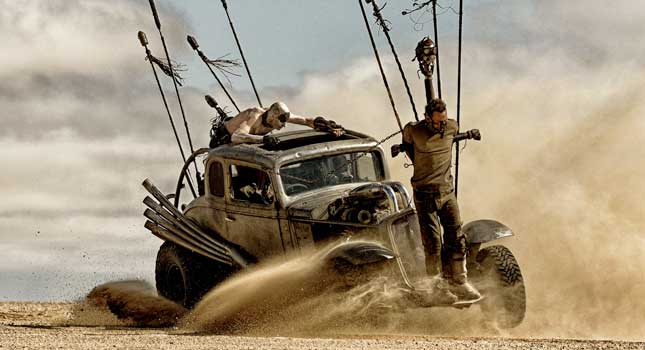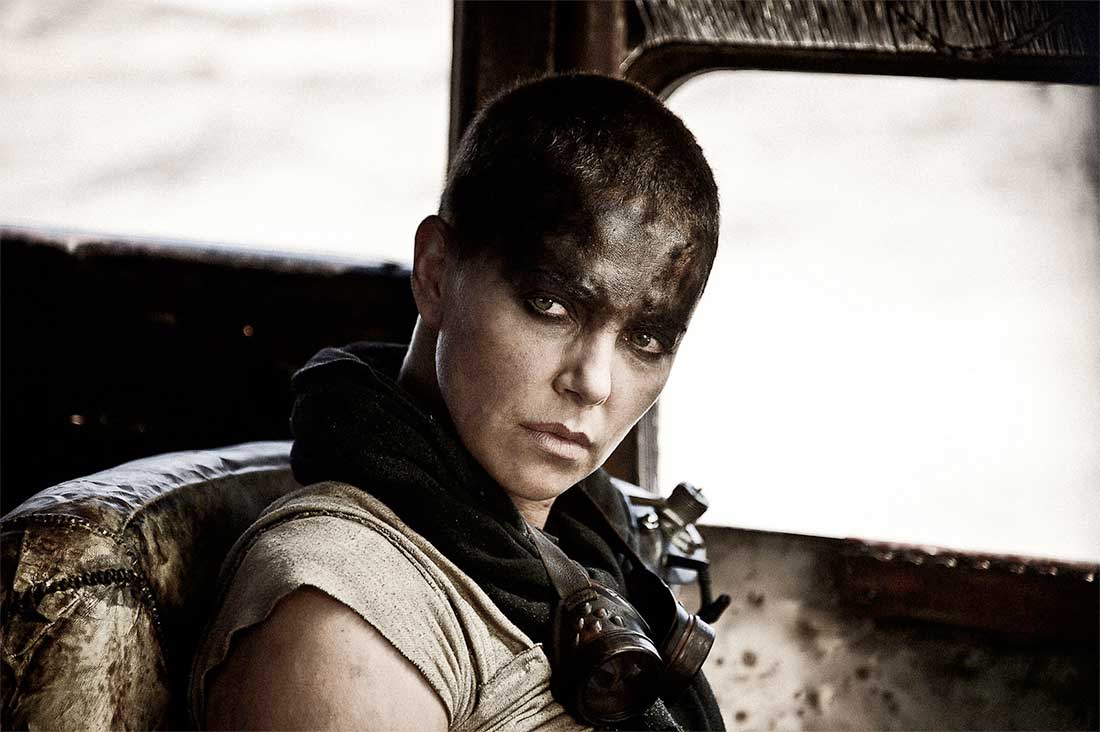
It’s fundamentally a dystopian chase movie of flaming rocket ship proportions, taking the concepts Miller first devised in the late 70s and early 80s and injecting the might of modern cinema into the nitrous oxygen fueled engine that drives its big, powerful wheels. However, there are a few holes in the character development and continuation of Max Rockatansky initially, which kind of halts your affinity with him and the film to begin with, but this eventually fades and you’re soon strapped into the front seat for another gas guzzling psycho ride through the Australian desert.
The story is a punk rock firecracker that picks up with a troubled Max as he’s chased down and imprisoned by the white painted menace that is a well tooled gang called the War Boys. They’re the road warrior soldiers of tyrannical oasis ruler, Immortan Joe, who uses his grip on the only real water source in the desert, along with his gas and munitions supply, to rule a downtrodden community that grovel at his egotistical feet. When Max finds himself strapped to the front of a chase car hot on the heels of a rogue former ally to Joe, Imperator Furiosa, he’s plunged into yet another mad, bad and messed-up sad running battle for salvation.
One of the cleverest devises Miller has added to the plot is the introduction of a twisted type of theology and martyrdom that takes a lot from old Norse religions, while commenting more on the devastating impact that extreme beliefs have had on the world over the last twenty years or so. Here it’s a belief in an afterlife that is paved with glory for anyone that gives their life in battle, a belief that Immortan Joe has instilled to give him the added advantage in his road wars and dominion over the people, land and resources around him. It says a lot about the origins of martyrdom and its benefit to the kings and leaders of the past, providing a smart critique that’s stark and unwavering in the light of modern day politics.
For anyone out there reading our review or having seen the film and left thinking it’s a preposterous concept that could never come to pass, we can definitely understand where you’re coming from, but you may want to think again. What makes George Miller so inspired isn’t his ability to spin up a far fetched storyline and make it solid and imposing in film form, it’s his understanding of the potential for humanity to descend into chaos. If you scoff at the plot of Fury Road, or any of the previous Mad Max movies, you might want to take an afternoon’s stroll in your local park or town centre and you’ll see hints of his universe in the everyday people that you find there. More importantly, look through the last hundred years of our history of wars and atomic control or flick through the international news section of any paper and you’ll find parallels in one form or another with Miller’s post-apocalyptic nightmare, which gives his work a lot more credibility than you might have thought.
What little dialogue there is it’s taught and direct, tying in well with the head-on force of the movie, but the sheer lack of dialogue and seeming inability to speak on the part of the now deep throated Max Rockatanski seems a little too threadbare to buy into. It’s this monosyllabic new direction, along with his initial lack of heart makes him seem too far removed from the Max we know of old. On a positive note, a lot is communicated without words in the looks, gestures and mannerisms of the main character, which is always impressive, but a big part of this success is in the onscreen dynamic between Max and his eventual co-driver, Furiosa, played brilliantly by Charlize Theron (The Road).
While Tom Hardy (Child 44) is pretty tight lipped in the role of “Mad” Max, he’s also visceral in action mode, combining up with Theron to create hard-hitting, foot to the floor movie sequences. However, it’s the latter who makes the film work as well as it does, providing the catalyst for the film’s main character development and emotional connection.
They’re escape cargo, Joe’s beautiful breeder wives, are played to perfection by Rosie Huntington-Whiteley, Riley Keough, Zoë Kravitz, Abbey Lee, Courtney Eaton and Megan Gale. They’re all supported well by Nicholas Hoult, who plays a War Boy called Nux who goes on to help them in their desperate flight across the raging desert sands. He provides our only real connection with the other side, and performs the transition from wild eyed fanatic, to salvaged reformer with a lot of skill.
A movie like Mad Max: Fury Road is often made by its leading antagonist and the crazy reality of the movie is that he’s played with sheer menage by Hugh Keays-Byrne, who also starred as the gang leader, Toecutter, from the very first Mad Max movie. He’s convincing beyond belief in the role of the tyrant leader, providing other key bad guys like his enforcer son Rictus Erectus, played surprising well by WWE wrestler Nathan Jones, with a strong ring leader to rally around.
Visually, the film is incredible with a lot of credit going to director of photography, John Seale (The Tourist), along with the set design, props, make-up, costume and special effects team. What’s more impressive is that they’re able to make things looks so cool as high speed or with brutal fight sequences running through it all, which shows the time, effort and dedication to creating something special that has gone into the film.
Overall, George Miller has definitely succeeded in delivering his brief to reintroduce Mad Max to a modern day audience and he’s done it with a lot of style in Fury Road. While it’s not quite the Max we know from before, it has given us a strong, silent scarred world warrior to rally behind and that’s not necessarily a bad thing. There’s been a lot of talk from Miller and Hardy about the prospect of further films in the series and with the success of the fourth entry in the furious canon, it looks like the prospect of a sequel is going to get a super charged, V8 shot to mechanical arm. It also adds to the excitement about the upcoming Mad Max computer game too.
Mad Max: Fury Road review: 4/5



